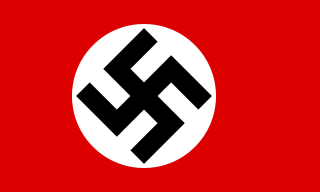 W
WDuring World War II, Reichskommissariat Ukraine was the civilian occupation regime (Reichskommissariat) of much of Nazi German-occupied Ukraine. It was governed by the Reich Ministry for the Occupied Eastern Territories headed by Alfred Rosenberg. Between September 1941 and August 1944, the Reichskommissariat was administered by Erich Koch as the Reichskommissar. The administration's tasks included the pacification of the region and the exploitation, for German benefit, of its resources and people. Adolf Hitler issued a Führer Decree defining the administration of the newly occupied Eastern territories on 17 July 1941.
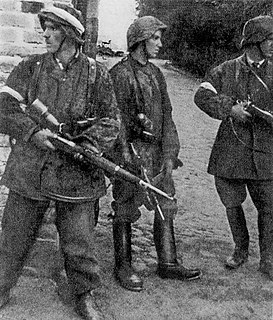 W
WThe 1943 Pinsk Prison raid was one of the most spectacular raids in the history of the Home Army and the Polish Underground State. It took place on 18 January 1943 in Pinsk, the town in Eastern Poland, which at that time was under German occupation as part of Reichskommissariat Ukraine. The purpose of the raid was to release a Cichociemni agent and his comrades, who had been captured by the Germans while trying to blow up the Horyn river bridge.
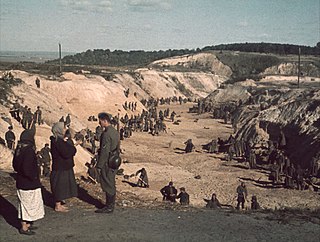 W
WBabi Yar is a ravine in the Ukrainian capital Kyiv and a site of massacres carried out by Nazi Germany's forces during its campaign against the Soviet Union in World War II. The first and best documented of the massacres took place on 29–30 September 1941, killing approximately 33,771 Jews. The decision to kill all the Jews in Kyiv was made by the military governor Generalmajor Kurt Eberhard, the Police Commander for Army Group South, SS-Obergruppenführer Friedrich Jeckeln, and the Einsatzgruppe C Commander Otto Rasch. Sonderkommando 4a troops, along with the aid of the SD and SS Police Battalions with the Ukrainian Auxiliary Police backed by the Wehrmacht, carried out the orders.
Adolf von Bomhard was an SS-Gruppenführer and Generalleutnant of the Ordnungspolizei in Nazi Germany. In the post-war era he was Bürgermeister of Prien am Chiemsee.
 W
WByło sobie miasteczko... is a 2009 Polish historical documentary film about the 1943 Kisielin massacre in the village of Kisielin, located in the Wołyń Voivodeship in Poland before World War II,. The film, directed by Tadeusz Arciuch and Maciej Wojciechowski, was produced by Adam Kruk for Telewizja Polska.
 W
WThe Death Match is a name given in postwar historiography to the football match played in Kyiv in Reichskommissariat Ukraine under occupation by Nazi Germany. The Kyiv city team Start, which represented the city's Bread Factory No.1, played several football games in World War II. The team was composed mostly of former professional footballers of Dynamo Kyiv and Lokomotyv Kyiv, all of whom were forced to work at the factory under the Nazi occupation authority and were made to produce bread for German soldiers.
 W
WThe Holocaust in Ukraine took place in the Reichskommissariat Ukraine, the General Government, Crimean General Government and some areas under military control to the East of Reichskommissariat Ukraine and as well in the Transnistria Governorate and Northern Bukovina and Carpathian Ruthenia in World War II. Between 1941 and 1944, more than a million Jews living in the Soviet Union were murdered by Nazi Germany's "Final Solution" extermination policies. Most of them were killed in Ukraine because most pre-WWII Soviet Jews lived in the Pale of Settlement, of which Ukraine was the biggest part.
 W
WErich Koch was a Gauleiter of the Nazi Party (NSDAP) in East Prussia from 1 October 1928 until 1945. Between 1941 and 1945 he was Chief of Civil Administration of Bezirk Bialystok. During this period, he was also the Reichskommissar in Reichskommissariat Ukraine from September 1941 until August 1944 and in Reichskommissariat Ostland from September 1944. After the Second World War, Koch stood trial in Poland and was convicted in 1959 of war crimes and sentenced to death. The sentence was never carried out and Koch died of natural causes in his cell at the Barczewo prison on the 12 November 1986.
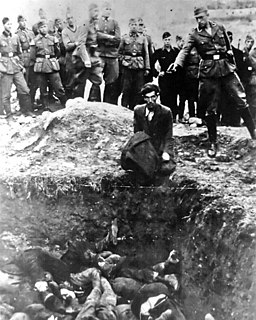 W
WThe Last Jew in Vinnitsa is a photograph taken during the Holocaust in Ukraine showing a Jewish man near the town of Vinnitsa (Vinnytsia) about to be shot dead by a member of Einsatzgruppe D, a mobile death squad of the Nazi SS. The victim is kneeling beside a mass grave already containing bodies; behind, a group of SS and Reich Labour Service men watch.
 W
WWaldemar Magunia was the leader of the Sturmabteilung (SA) in East Prussia and Commissioner General in Kiev.
 W
WThe massacres of Poles in Volhynia and Eastern Galicia, were carried out in German-occupied Poland by the Ukrainian Insurgent Army, or the UPA, with the support of parts of the local Ukrainian population against the Polish minority in Volhynia, Eastern Galicia, parts of Polesia and Lublin region from 1943 to 1945. The peak of the massacres took place in July and August 1943. Most of the victims were women and children. Many of the Polish victims regardless of age or gender were tortured before being killed; some of the methods included rape, dismemberment or immolation, among others. The UPA's actions resulted in between 50,000 and 100,000 deaths.
 W
WSchutzmannschaft Battalion 118 was a Schutzmannschaft auxiliary police battalion (Schuma). The core of the Schutzmannschaft battalion 118 consisted of Ukrainian nationalists from Bukovina in Western Ukraine. It was linked to the ultra-nationalist Organization of Ukrainian Nationalists, to its smaller Melnyk wing. 900 members of The OUN in Bukovina marched towards eastern Ukraine as members of paramilitary Bukovinian Battalion. After reinforcement by volunteers from Galicia and other parts of Ukraine, the Bukovinian Battalion had a total number of 1,500–1,700 soldiers. When the Bukovinian Battalion was dissolved, many of its members and officers were reorganized as Schutzmannschaft Battalions 115 and 118. Among the people incorporated into the Schutzmannschaft Battalions 115 and 118 were Ukrainian participants in the Babyn Yar massacre.
 W
WSyrets was a Nazi concentration camp established in 1942 in Kyiv's western neighborhood of Syrets, part of Kyiv since 1799. The toponym was derived from a local small river. Some 327 inmates of the KZ Syrets were forced to remove all traces of mass murder at Babi Yar.
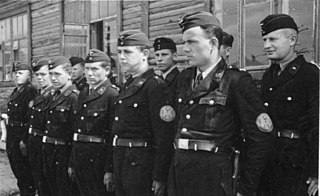 W
WThe Ukrainische Hilfspolizei or the Ukrainian Auxiliary Police was the official title of the local police formation set up by Nazi Germany during World War II in Reichskommissariat Ukraine, shortly after the German conquest of the Ukrainian Soviet Socialist Republic in Operation Barbarossa against the Soviet Union, Germany's former co-belligerent in the invasion of Poland.
 W
WMassacre of Wola Ostrowiecka was a 1943 mass murder of Polish inhabitants of the village of Wola Ostrowiecka located in the prewar gmina Huszcza in Luboml County of the Volhynian Voivodeship, within the Second Polish Republic. Wola Ostrowiecka no longer exists. It was burned to the ground during the Massacres of Poles in Volhynia and Eastern Galicia.